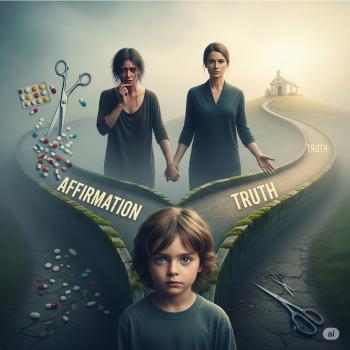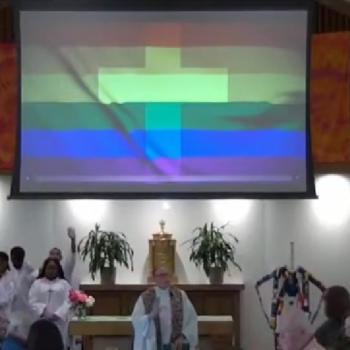The sacramental logic, inscribed in the Trinitarian revelation, is prolonged and condensed in the sacraments, in which Christ makes himself present in a particularly intense way (SC 7). The sacramental structure and logic of faith hang on Jesus Christ, the Incarnate and redeeming Word. (THE RECIPROCITY BETWEEN FAITH AND SACRAMENTS IN THE SACRAMENTAL ECONOMY, The Incarnation: Center, Summit, and Key to the Sacramental Economy, 31)
Sacramental Logic
Some outside the Catholic Church may wonder why Catholics (both Roman Catholic and Eastern Orthodox) think Sacraments are a “big deal.” What is so wonderous about water (baptism), bread and wine (the Eucharist), oil and laying on of hands (Confirmation), the priest hearing confessions (Reconciliation), oil, prays of healing, and laying on of hands (Anointing of the Sick), laying on of hands and consecration (Holy Orders), and a baptized couple freely giving themselves to each other for life (Matrimony)? This question can be answer with two words: the Incarnation. Christ Incarnate is God’s first, ultimate, and prime Sacrament (the Ur-Sakrament).
For in Jesus Christ, as the summit of history and the fullness of time (Gal 4:4), there is the closest possible unity between a creatural symbol, its humanity, and what is symbolized, the saving presence of God in his Son in the midst of history. Christ’s humanity, as humanity inseparable from the divine person of the Son of God, is a “real symbol” of the divine person. In this supreme case, the created communicates to the highest degree the presence of God. (THE RECIPROCITY BETWEEN FAITH AND SACRAMENTS IN THE SACRAMENTAL ECONOMY, 30)
A God Who Desired Physical Touch
Before the Incarnation, God was pure spirit. He communicated through angels (Genesis 18), by speaking to and through prophets (e.g., Isaiah, Jeremiah, Ezekiel, and Daniel), and through signs, like the burning bush (Exodus 3). Such methods were effective in communicating the might and power of the one true God. These methods could also invoke terror and the dangers of the unfiltered presence of a holy God. Moses glowed after coming down from Mount Sinai after conversing with God (Exodus 34:29). God also warned Moses that he could not see His face, “for man shall not see me and live” (Exodus 33:20). How does a mighty God who desires an intimate relationship with His creatures bridge the eternal divide and limitations of human existence? He become a man. He takes on humanity and forever connects it to the Godhead.
1 In the beginning was the Word, and the Word was with God, and the Word was God. 2 He was in the beginning with God. 3 All things were made through him, and without him was not any thing made that was made. 4 In him was life, and the life was the light of men. 5 The light shines in the darkness, and the darkness has not overcome it.
14 And the Word became flesh and dwelt among us, and we have seen his glory, glory as of the only Son from the Father, full of grace and truth. (John 1:1-5, 14. English Standard Version)
He Became Flesh and Dwelt Among Us

It is precisely because God desired physical touch that He “became flesh and dwelt among us.” By taking on flesh, humanity has an eternal physical linked to God. In Jesus’ humanity, God experienced hunger, thirst, heat, cold, loss of a parent (Joseph), loss of a friend (Lazarus), love, joy, laughter, pain, abuse, and death. In Jesus, our God has also wept (John 11:35).
15 For we do not have a high priest who is unable to sympathize with our weaknesses, but one who in every respect has been tempted as we are, yet without sin. (Hebrews 4:15)
Likewise, we have a God who sympathizes with our weaknesses. A God who knows us. One we can physically touch (John 20:27) and who can physically touch us (Matthew 8:3). In Jesus, we have the touchable God. It is in this touch that we find the Sacraments. We did not cease to need the physical presence of our Lord once He ascended into heaven. In fact, we needed it more.
The Sacramental Personal Touch of Jesus
Moreover, after the Ascension, Jesus sent the Holy Spirit to His Church. This ushered in what the Catechism of the Catholic Church (CCC) calls the “dispensation of mystery” (Catechism of the Catholic Church 1076). Mystery in the Greek New Testament is mysterion, which in Latin become sacramentum or sacrament. The “mystery” or “sacrament”: Christ’s continued physical and spiritual presence in His peoples’ lives. All sacraments find their source in the life of Jesus.
1115 Jesus’ words and actions during his hidden life and public ministry were already salvific, for they anticipated the power of his Paschal mystery. They announced and prepared what he was going to give the Church when all was accomplished. the mysteries of Christ’s life are the foundations of what he would henceforth dispense in the sacraments, through the ministers of his Church, for “what was visible in our Savior has passed over into his mysteries.” (St. Leo the Great Sermo. 74, 2: PL 54, 398.)
1116 Sacraments are “powers that comes forth” from the Body of Christ, (Lk 5:17; 6:19; 8:46) which is ever-living and life-giving. They are actions of the Holy Spirit at work in his Body, the Church. They are “the masterworks of God” in the new and everlasting covenant.
Furthermore, in section 1088 of the CCC states, “By his power he is present in the sacraments so that when anybody baptizes, it is really Christ himself who baptizes.”
Corporeal and Spiritual Beings
Saint Pope John Paul II states that being created in the image of God humans are “both a corporeal and spiritual being.” As corporeal we relate to the external world physically via five senses. We see, hear, smell, touch, and taste the world. We are therefore sensory dependent. All information from the outside world must come through our senses, for instance. Our most endearing relationships involve physical intimacy. The embrace of a dear friend, the snuggles of mother and child, and the union of husband and wife are all examples of the most intimate connections humans share through physical touch. The latter of which produces the miracle of human procreation. Physical human intimacy has the potential to produce life itself!
Because we are both corporal (physical) and spiritual beings, the second Person of the Trinity took on flesh and lived among us. It is also because we are both corporal (physical) and spiritual beings that Christ gives us the Seven Sacraments. In the Sacraments, God physically and spiritually touches us.
Like what you read? Please check out my other writing here.
Please like and follow me on Facebook.












